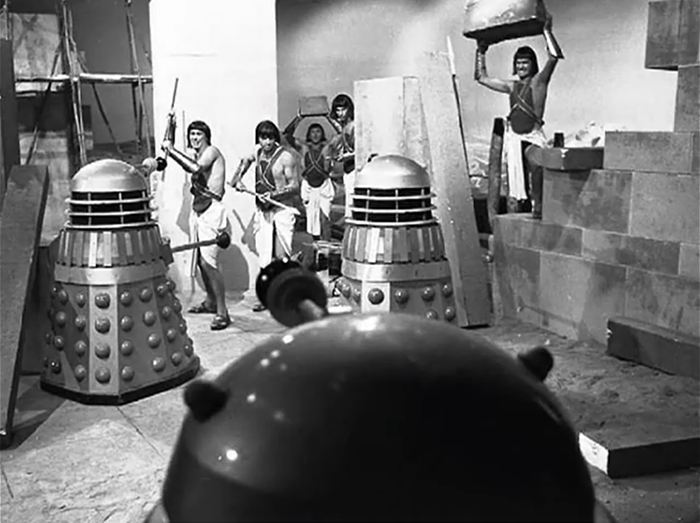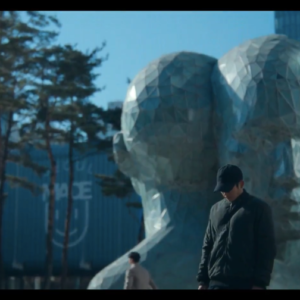The Doctor: First Doctor (William Hartnell)
The Companions: Vicki (Maureen O’Brien), Steven (Peter Purves)
The plot: The Doctor gets caught in a battle of wits with another time traveller in 11th century England
Written By: Dennis Spooner
First aired: 03/07/1965-24/07/1965
Continuity: We meet another member of the Doctor’s people for the first time
Steven joins the TARDIS as a companion
History can be changed, the Doctor just chooses not to do it
The Doctor Who universe is a single timeline universe where changes in the past simply rewrite history
Season 2, Episodes 37-40 review

You know as well as I do the golden rule about space and time travelling. Never, never interfere with the course of history.
The Doctor, on time travel
The final serial of Doctor Who’s second season pits the Doctor against his darker half; another traveller in the fourth dimension with a strange fixation on Earth.
The Monk is also a brilliant but capricious trickster who revels a little too much in his own feelings of superiority. Not villainous per se, but capable of doing harm through his stubbornness and arrogance. A meddler more than a destroyer. Not an equal and opposite to the Doctor so much as a mirror image: the same but with marginal differences and only when viewed from the perspective of someone on this side of the looking glass.
And the difference between those two mirror images?
History. The respect of history and its natural flow.
Can history be changed? Should history be changed? Do we observe it or amend it?
Until now, Doctor Who has been clear that time could not be changed and any of our efforts to do so would fail [The Aztecs, The Crusade, The Reign of Terror]. The timeline is inviolate: not by convention but by physical law.
With The Time Meddler, the producers of Doctor Who take a sharp detour from this philosophy. History can change. Time can be rewritten. The Doctor just chooses not to. More importantly, he will stop those who choose to try. Considering how the previous serial, The Space Museum, unfolded we also begin to see the nascent stage of a more complete overarching philosophy.
Time can be rewritten but it shouldn’t be except in certain specific circumstances and the Doctor is the arbiter of that decision.
The place of the Doctor and the Monk’s cerebral battlefield is a literal one: Northumbria in 1066, before the Battle of Stamford Bridge. The Anglo Saxon King, Harold Godwinson, defeated a Viking invasion only to lose to the Normans at the Battle of Hastings less than a month later (in fact the Norman fleet landed just three days after the Battle of Stamford Bridge). Harold had been faced with a terrible dilemma: to ignore the Northern invasion to prepare for the impending Southern one or try to fight both. And if it were not for his forced march northwards to face King Harald Hardrada (and subsequent race southwards to meet the second invading army), then, it could be argued, he would not have lost to William the Conqueror. England would have stayed in Anglo Saxon hands.
Whether this would have accelerated the advance of civilisation and put an early end to the Dark Ages is up for debate by greater minds than mine. But it is the motivation of The Monk (or at least one of them, if his stash of artefacts is anything to go by).
The Monk’s plan is actually quite simple: to gun down the Norwegian fleet using advanced future weaponry so that Harold’s forces will stay where they are and be fresh to face the Normans when they land. The simplicity of the Monk’s plan and Spooner’s decision to set his plot in an abandoned monastery near a small local village, means that he takes a lighter touch to history than in his previous historicals. The Doctor and his companions aren’t walking around in history so much as peering at it from a space in between big events.
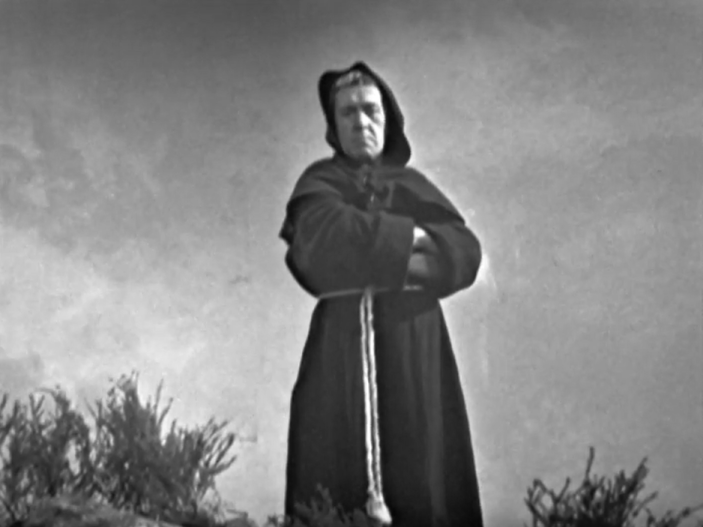
While my watchmate, Eazal, has strong opinions on the wardrobe and hairdressing of this mediaeval setting – opinions she has graciously shared in a guest post – it doesn’t distort history like previous Spooner stories (although his tendency to sexually assault female characters should have earned him some therapy at the least). It is ironic, in fact, that the last of Spooner’s stories for Doctor Who is the most enjoyable. Probably because history is more of a backdrop to the story than the point.
As the TARDIS lands on the rocky windswept shores of northern England in the 11th century, a monk stares pensively at the arriving blue box. Inside, Vicki and the Doctor discover they have two stowaways: the raggedy future Earth man, Steven, and his panda, HiFi. The image of the large square-jawed Steven with his beloved stuffed toy is delightful and I’m kind of disappointed that most of his episodes are lost. It is a lovely visual contrast, something that works well with the two-natured aspect of the Doctor and of the TARDIS itself.
That is the dematerialising control and that, over yonder, is the horizontal hold. Up there is the scanner, those are the doors, that is a chair with a panda on it. Sheer poetry, dear boy.
The Doctor on the TARDIS
As The Time Meddler opens, a new era of Doctor Who begins and the TARDIS is rather appropriately peopled by the exiled and the traumatised, those with nowhere else to go and no place where they belong. And while the producers are not yet ready to put a name either to the Doctor’s planet or to his people, it’s appropriate that our first meeting with another of his own kind is also with an exile.
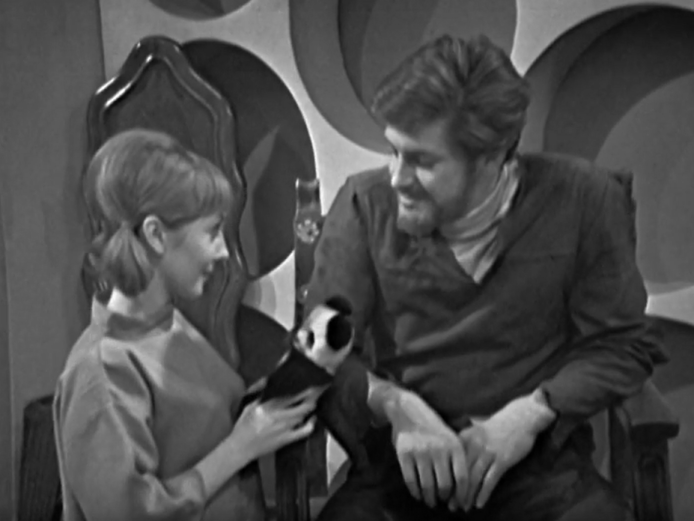
Steven here is sceptical about time travel to the point of denial. He’s also stubborn and a bit rash and it’s clear he was brought in to take over Ian’s action elements. Two years in captivity has made him voluble but also aggressive: in the first episode he attacks a man in the forest for no reason other than he thinks he might have taken something that belongs to them. But he brings out a witty and playful side in Vicki who rises to her new role as senior TARDIS traveller and Doctor wrangler. Steven is a perfect foil for her, his exuberance bringing out her own. And with Maureen O’Brien being a delightful and engaging actor, Vicki is finally the enjoyable character I remember her being.
The Doctor and Steven have a bit of banter over the capabilities of the TARDIS, the Doctor’s words somewhat undermined by the fact the rackety old thing is broken. Yes it should be a rock against the cliff face but is stuck as a police box. Yes it should tell them where they’re going and where they are but that’s broken too. Still, the old girl works well enough to deposit the Doctor in the exact time and place he needs to be to stop the Monk so, even back in the ’60s, the idea that the TARDIS is directing the Doctor’s movements is a compelling one.
The Doctor, incensed at Steven’s disbelief, takes off at breakneck speed to find proof they are in Earth’s past and ends up lost near the monastery at nightfall, where he is given hospitality by local woman, Edith (played by Alethea Charlton, who also played Hur from the Stone Age). As the sounds of the monk’s chants fill the night air, the track slows like a bad tape recording and the Doctor realises it’s fake. He heads to the monastery and finds, of all things, a gramophone.
The beauty of the gramophone is that it’s an antique from our perspective yet too advanced for the 11th century. It’s also something that needs winding to stop it slowing down. So as far as lures go, it’s the perfect one: anachronistic enough to be noticed but flawed enough to make the mistake.

And a lure it is. While the Doctor gives his trademark snicker at uncovering the monastery scam, bars come down that trap him in the small room. Now it’s time for the Monk to mirror the snicker back at him. The Doctor has been played.
It’s important to note that the Monk wants merely to sideline the Doctor to give him time to execute his plan. He doesn’t hurt him and even makes him up a breakfast tray with a china tea cup. In fact, the Monk hurts no one throughout this four-parter, even injured locals who come to the Monastery for assistance.
If anything, the Monk comes across as an almost-endearing crotchety old man who keeps a To Do List for his master plan on the wall and cantankerously gives the local Saxons penicillin as though they’re annoying kids who keep getting in the way of his grand schemes.
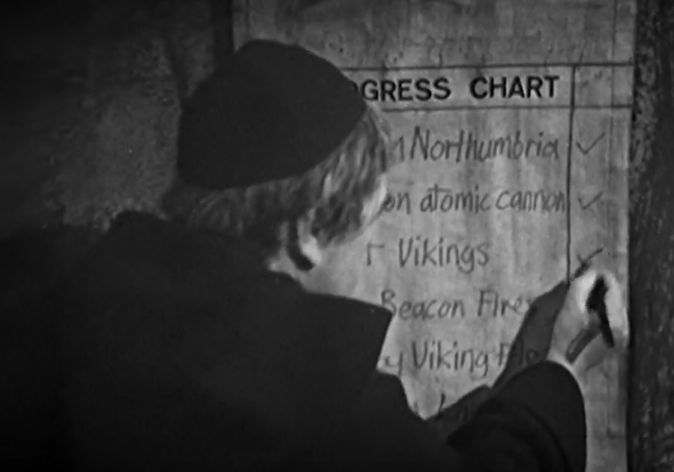
While the Monk waits for the Viking fleet to be close enough to destroy (we’re at Step 3 on his Progress Chart as above), a forward party is moving through the area. Small skirmishes are occurring, especially after they rape Edith (which of course is the only reason Spooner put a female character in the script, I won’t harp on this point too much because I like this serial and I think it’s well written but Spooner’s misogynism gives me hives).
With both locals and Vikings trooping through the monastery and Edith starting to become suspicious of the Monk, Vicki and Steven discover enough evidence to convince Steven that they are in 11th century England but that something is very wrong. Their feeling is only heightened when they find the Monk’s atomic cannons near the cliffs. And of course the episode 3 cliffhanger, involves the two of them stumbling into the Monk’s TARDIS. It would have been an amazing revelation for a series two audience.
It’s a Tardis. The Monk’s got a Tardis!
Vicki, The Time Meddler
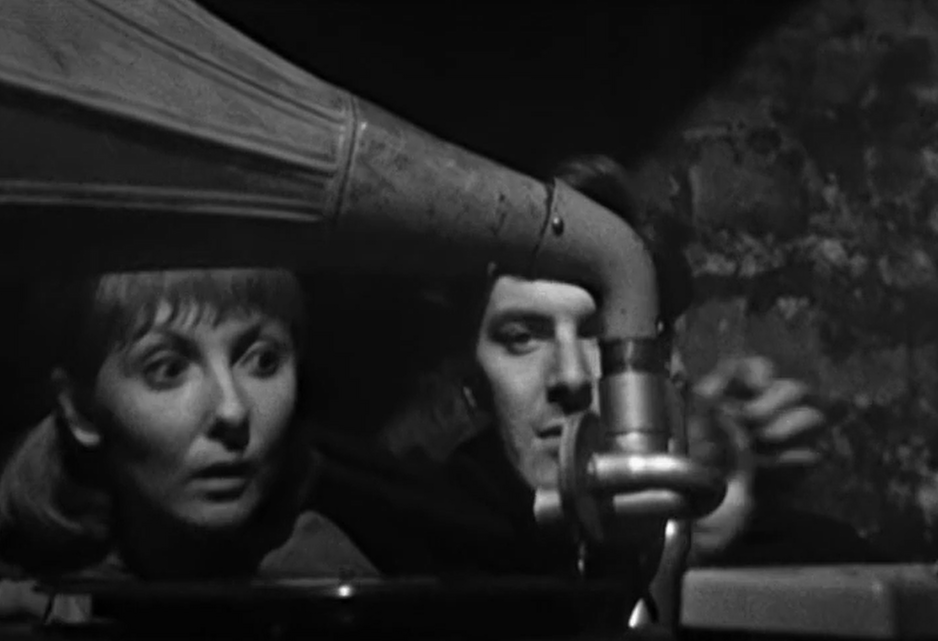

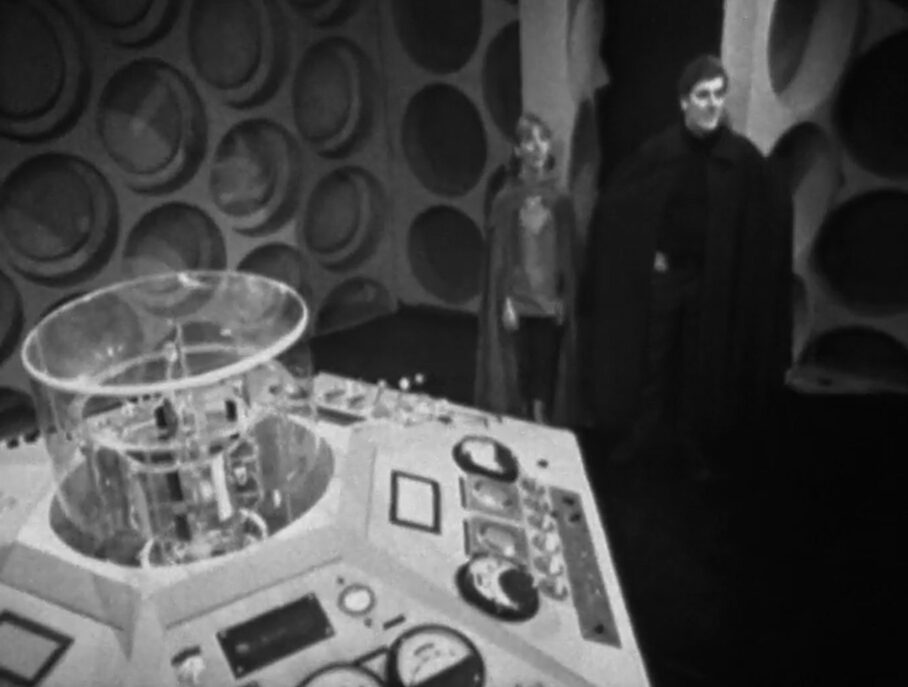
Unlike the Doctor’s TARDIS, the Monk’s has a working chameleon circuit (although not named as such). It is currently disguised as a Saxon sarcophagus and is filled to the brim with items from history. As well as meddling, the Monk is a pilferer.
The Monk gets the drop on the Doctor and his two companions and ties them up in his TARDIS. This prompts Vicki and Steven to discuss contemporary time travel theory, situated as this show was before the development of the multiverse theory of time travel.
The exact minute, the exact second that he does it, every history book, every, well, the whole future of every year and time on Earth will change, just like that and nobody’ll know that it has?
Steven, summing up the paradox problems of classic time travel theory
Time can be rewritten.
But the Doctor isn’t going to let that happen. As it turns out, he’s dropped enough cryptic comments into the local’s ears for them to suspect that the Monk isn’t who he says he is. With the belief that he’s a Viking spy, they try to capture him before he can destroy the Viking fleet. With this plans (temporarily) thwarted, he runs back to his TARDIS only to discover that the Doctor has taken his dimensional circuit. His TARDIS interior is jammed in a miniaturised version, too small for him to enter. He is trapped in 11th century England.
The Doctor and his companions return to the TARDIS and dematerialise. History has been saved, at least for now. And so the second season of Doctor Who ends.

